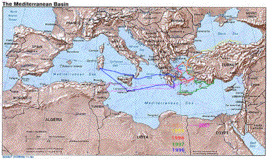This page gives some help with reading the Thetis logs. If you find anything mentioned here confusing, or if you would like any non-covered feature to be included, please send me some e-mail. It is highly recommended that you use a modern, HTML5 compliant, browser such as: Firefox, Safari, Google Chrome, and Opera. Internet Explorer has a long history of not complying with The World Wide Web Consortium (W3C) standards.
- Electronic Mail (e-mail)
It appears as a mailbox icon. You just click on the icon and you can send me mail.
- Links
-
Links appear as Thetis. When you move your mouse over the link, it changes color. You just click on them, and you are transported to a new page with that information. Once you finish reading this new page, you can return back by clicking the "back" button on your browser (usually Apple Safari, Firefox, Camino, Opera, or the latest Microsoft Explorer). After you have visited a link, it changes to another color as a reminder that you have been there.
- Dynamic Maps
-
Most maps shown in this website are dynamic. That is, they contain active areas where if you click, you are transported to the appropriate place in the page. As you move your cursor over the map, it changes shape. If it is outside an active area it is an arrow, when it gets over an active area it changes to a finger. In addition, the status area on your browser (usually at the lower left corner) displays where you will be transported. If you hover over the active area the same descriptive message also appears in a pop-up. The exact behavior depends on the specifics of your browser. For example, move your cursor over Spain, Italy, or Greece on the map, wait a few seconds, and click.

- Home menu item
-
This is the first item of the menu at the top-right of the page. When pressed, it brings the home page of this website.
- Newest Log menu item
-
This is the second item of the menu at the top-right of the page. When pressed, it brings the first page of the Newest Log on this website.
- Specifications Log menu item
-
This is the third item of the menu at the top-right of the page. When pressed, it brings the first page of the Specifications of S/Y Thetis.
- Help Log menu item
-
This is the fourth item of the menu at the top-right of the page. When pressed, it brings this help page.
- Google Search
-
Google search is available on the upper right corner on all web pages. If you leave the “Thetis only” box ticked, the search is restricted to this site, otherwise it is the usual Google search throughout the web.
- Cruising Wiki
-
This button, on the upper right corner on all web pages, links you to the Cruiser Log Wiki that contains a wealth of harbor and passage information. Most of my notes, kept over the last 25 years are now included on this wiki.
- Top Menu Item
-
This is the first item of the menu at the bottom of the page. When pressed, it brings to the top of the current page.
- Links Menu Item
-
This is the second item of the menu at the bottom of the page. When pressed, it brings up a page with a listing of several useful links.
- Acknowledgements Menu Item
-
This is the third item of the menu at the bottom of the page. When pressed, it brings up a page with acknowledgements to people who have helped with these travels.
- Contact Menu Item
-
This is the fourth item of the menu at the bottom of the page. When pressed, it brings up a page with instruction on how to contact me.
- Terms Menu Item
-
This is the fifth item of the menu at the bottom of the page. When pressed, it brings up a page with all the legalese about fair use of this website.
- Number of Visitors
-
This display is at the lower right corner of the Thetis main page. It displays the number of original visitor (not repeat visitors) to the Thetis website.
- Acronyms & Abbreviations
-
In some of the newer browsers, when you move and linger the mouse over an acronym or an abbreviation, it is expanded. For example, move the cursor over VHF and hover there for a while.
- Spelling of Greek Names
-
The spelling of Greek Names in English is a challenge as there is no consistent system. The Modern Greek language has many letters and/or combination of letters that are pronounced the same way. Classicists traditionally spell Greek words in English in a form that parallels Ancient Greek (for example “Oi Poloi”). In Greece today the tendency is to simplify and use just one letter i.e. use i for any of the six Greek letters or diphthongs (iota, eta, upsilon, epsilon-iota, omicron-iota,upsilon-iota) which are pronounced as “i” as in “ill” (in this usage the above example would be written as “I Poli”).
I have steered a middle course. If a name appears in well known translations of classical texts I keep this spelling otherwise I use the simplified form i.e. I use Kalymnos instead of Kalimnos but Lipsi instead of Lipsoi.